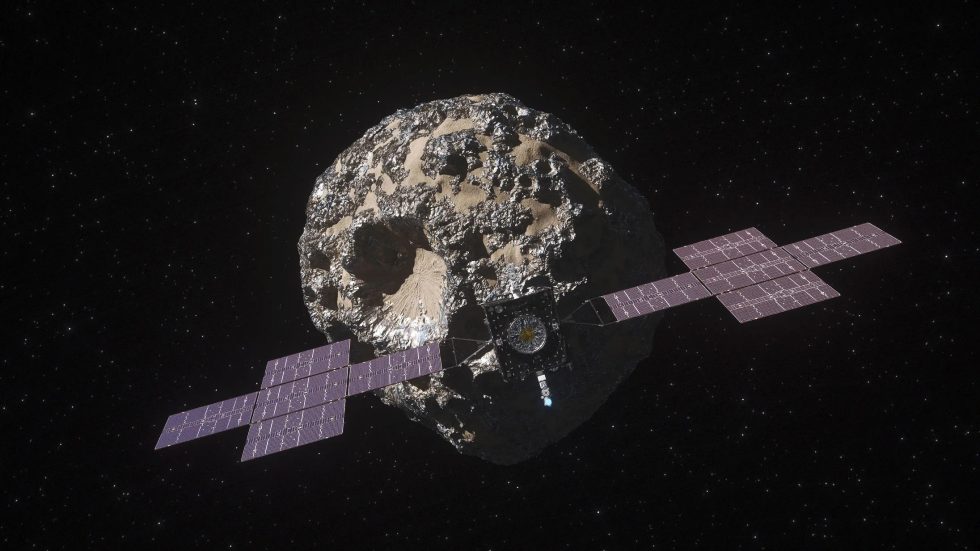“This kind of thing happens and that’s why we build redundancy into our missions."
NASA's Psyche spacecraft, located nearly 150 million miles from Earth on the way to an unexplored metal asteroid, has stopped firing its engines after detecting a problem in its propulsion system.
NASA published an update Tuesday revealing that the robotic spacecraft shut off its plasma thrusters earlier this month. The news wasn't widely shared until Wednesday, when NASA science chief Nicky Fox posted it on X.
"Engineers with NASA’s Psyche mission are working to determine what caused a recent decrease in fuel pressure in the spacecraft’s propulsion system," the agency said. The spacecraft detected the drop in pressure April 1 inside the line that feeds xenon fuel to the spacecraft's four plasma thrusters.
Sensors aboard the Psyche probe detected a pressure reduction in the xenon fuel line from about 36 pounds per square inch to about 26 psi. "As designed, the orbiter powered off the thrusters in response to the decrease," NASA said.
The Psyche spacecraft uses solar electric propulsion, a highly efficient means of maneuvering through space that relies on solar-generated electricity and more than a ton of xenon gas stored in seven 22-gallon (82-liter) tanks. Inside each of the mission's four thrusters, an electromagnetic field ionizes the xenon gas before expelling the ions to produce thrust.
These things happen
Louise Prockter, director of NASA's planetary science division, said engineers at the Jet Propulsion Laboratory in California are looking into the problem.
So far, there's no effect on the Psyche spacecraft's trajectory. Psyche's plasma thrusters can remain unpowered until at least mid-June before the spacecraft would begin to drift off course, according to NASA. Mission managers decided to keep Psyche's engines turned off until they better understand the pressure decrease. If engineers trace the problem to the fuel line itself, NASA has the option of switching to a backup fuel line to resume thrusting.
"This kind of thing happens and that’s why we build redundancy into our missions," Prockter said at a meeting of Mars scientists Wednesday. "We don't have any concerns at the moment about it, but we’re obviously keeping tabs on it.”

Each electric thruster on Psyche generates just 250 milli-newtons of thrust, roughly equivalent to the weight of three quarters. But they can operate for months at a time, and over the course of a multi-year cruise, these thrusters provide a more efficient means of propulsion than conventional rockets.
The plasma thrusters are reshaping the Psyche spacecraft's path toward its destination, a metal-rich asteroid also named Psyche. The spacecraft's four electric engines, known as Hall effect thrusters, were supplied by a Russian company named Fakel. Most of the other components in Psyche's propulsion system—controllers, xenon fuel tanks, propellant lines, and valves—come from other companies or the spacecraft's primary manufacturer, Maxar Space Systems in California.
The Psyche mission is heading first for Mars, where the spacecraft will use the planet's gravity next year to slingshot itself into the asteroid belt, setting up for arrival and orbit insertion around the asteroid Psyche in August 2029.
Psyche launched in October 2023 aboard a SpaceX Falcon Heavy rocket on the opening leg of a six-year sojourn through the Solar System. The mission's total cost adds up to more than $1.4 billion, including development of the spacecraft and its instruments, the launch, operations, and an experimental laser communications package hitching a ride to deep space with Psyche.
Psyche, the asteroid, is the size of Massachusetts and circles the Sun in between the orbits of Mars and Jupiter. No spacecraft has visited Psyche before. Of the approximately 1 million asteroids discovered so far, scientists say only nine have a metal-rich signature like Psyche. The team of scientists who put together the Psyche mission have little idea of what to expect when the spacecraft gets there in 2029.
Metallic asteroids like Psyche are a mystery. Most of Psyche's properties are unknown other than estimates of its density and composition. Predictions about the the look of Psyche's craters, cliffs, and color have inspired artists to create a cacophony of illustrations, often showing sharp spikes and grooves alien to rocky worlds.
In a little more than five years, assuming NASA gets past Psyche's propulsion problem, scientists will supplant speculation with solid data.
Hope you enjoyed this news post.
Thank you for appreciating my time and effort posting news every day for many years.
News posts... 2023: 5,800+ | 2024: 5,700+ | 2025 (till end of March): 1,357
RIP Matrix | Farewell my friend ![]()



3175x175(CURRENT).thumb.jpg.b05acc060982b36f5891ba728e6d953c.jpg)
Recommended Comments
There are no comments to display.
Join the conversation
You can post now and register later. If you have an account, sign in now to post with your account.
Note: Your post will require moderator approval before it will be visible.